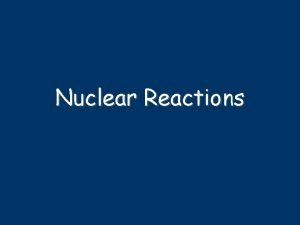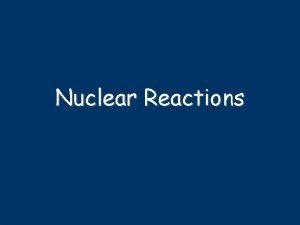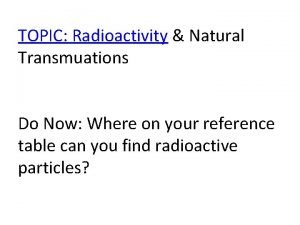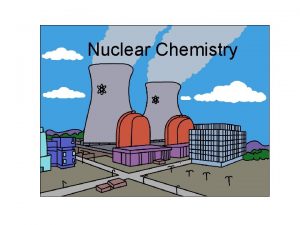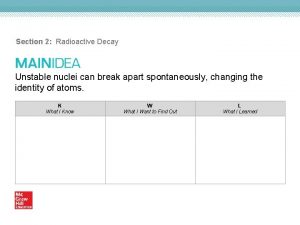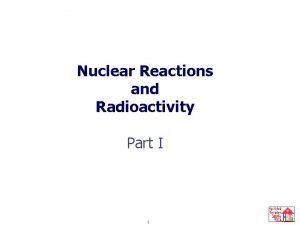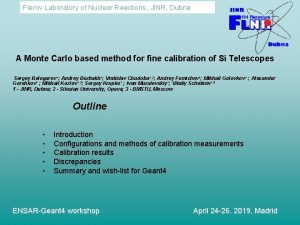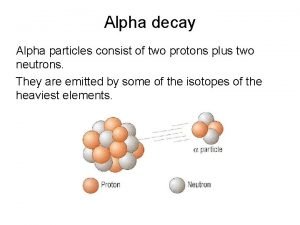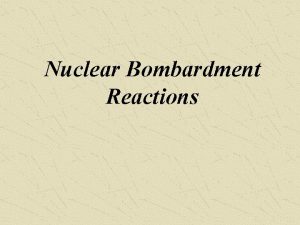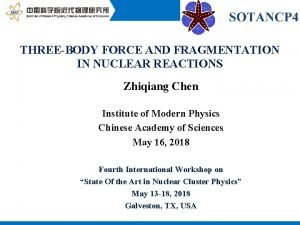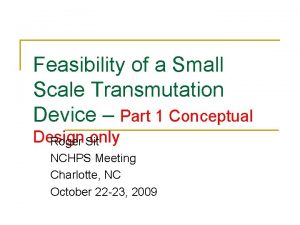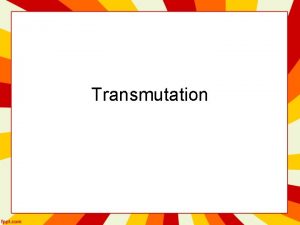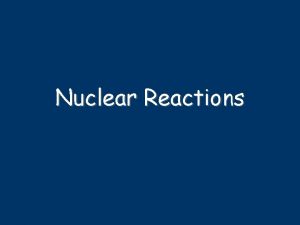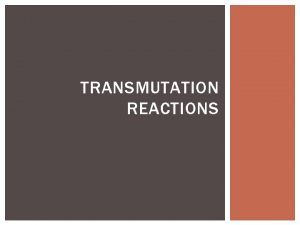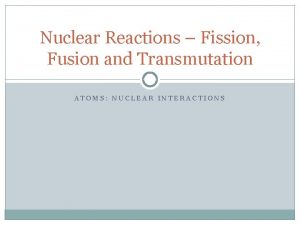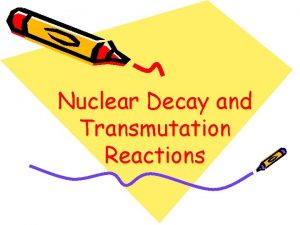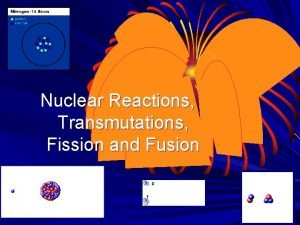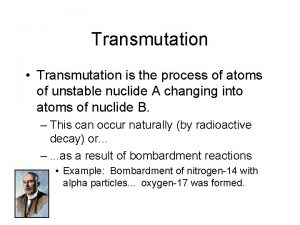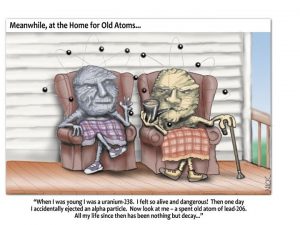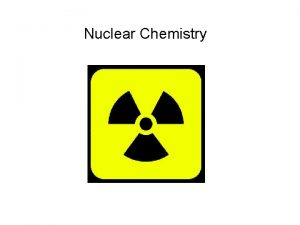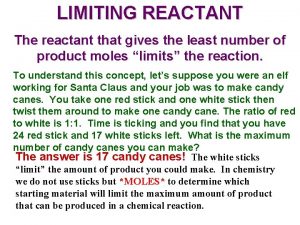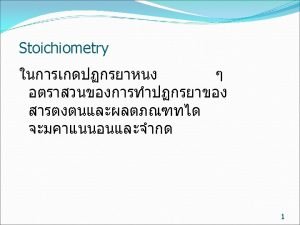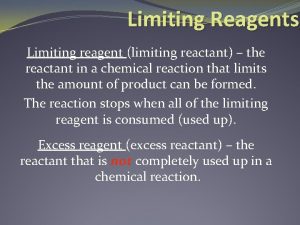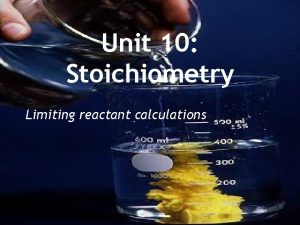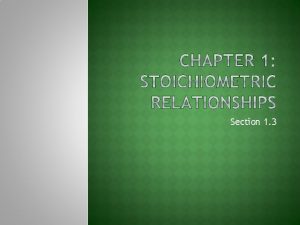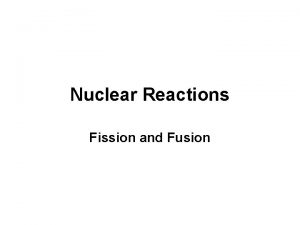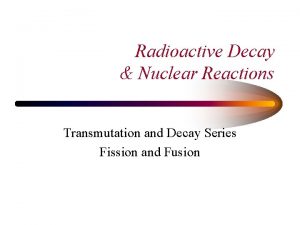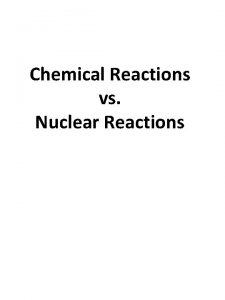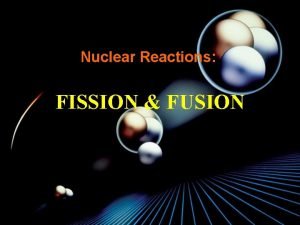Nuclear Reactions Natural Transmutation 1 term on reactant



































- Slides: 35

Nuclear Reactions

Natural Transmutation 1 term on reactant side Original isotope 2 terms on product side Emitted Particle New Isotope Happens all by itself (spontaneous) Not affected by anything in environment

Natural Transmutation 16 N 7 1 term on reactant side 0 e -1 + 16 O 8 2 terms on product side

Artificial Transmutation cause to happen: smash particles into one another 2 terms on reactant side Original Isotope Particle that hits it • neutron, proton, or -particle Product side: usually 2 terms

Artificial Transmutation 27 Al 13 + original isotope or target nucleus 4 He 2 30 P 15 + 1 n “bullet” 0 -what hits isotope

Artificial Transmutation 27 Al 13 14 N 7 + 4 He 30 P + 1 n 2 0 15 + 42 He 178 O + 11 H 75 As 33 + 4 He 78 Br + 1 n 2 0 35 37 Cl 17 + 1 n 38 Cl 17 0 all these equations have 2 reactants!

Bombarding with protons or protons & -particles have positive charge and mass • do some damage when hit target nucleus • must be accelerated to high speeds to overcome repulsive forces between nucleus & particle (both are +)

What is an accelerator? vacuum chamber (usually long pipe) • surrounded by vacuum pumps, magnets, radiofrequency cavities, high voltage instruments & electronic circuits inside pipe particles are accelerated to very high speeds then smashed into each other

Fission Reaction splitting heavy nucleus into 2 lighter nuclei requires critical mass of fissionable isotope • controlled: nuclear reactor • uncontrolled: bomb

Fission q reactant side: 2 terms 1 heavy isotope (examples: U-235 or Pu-239) bombarding particle – usually a neutron product side: at least 2 terms 2 medium-weight isotopes 1 or more neutrons huge amount energy released Fission = Division

Fission Chain Reaction

Fission 235 U 92 + 1 n 91 Kr + 142 Ba + 31 n + energy 0 56 235 U 92 1 n + energy + 1 n 72 Zn + 160 Sm + 4 62 0 0 36 30 0 more than 200 different product isotopes identified from fission of U-235 small amount of mass is converted to energy according to E = mc 2

Fusion reactant side has 2 small nuclei: • H + H; H + He; He + He product side: • 1 nucleus (slightly larger; still small) and maybe a particle source of sun’s energy 2 nuclei unite 2 H 1 + 13 H 24 He + 10 n + energy

CERN 27 kilometer ring • particles travel just below speed of light • 10 hrs: particles make 400 million revolutions of ring

Fermi. Lab 4 miles in circumference!


Balancing Nuclear Equations

Nuclear Equations - tasks identify type (4 types) balance to find unknown term

Natural Transmutation – ID 1 term on reactant side • starting isotope 2 terms on product side • ending isotope & emitted particle type of particle emitted characteristic of isotope – Table N

Nuclear Equations to balance: use conservation of both atomic number & mass number • mass number = left superscript • atomic number = left subscript

Balancing Nuclear Equations 16 N 7 0 e -1 + 16 O 8 conservation of mass number: 16 = 0 + 16 conservation of atomic number: 7 = -1 + 8

Writing Equations write equation for decay of Thorium-232 use Table N to find decay mode: α write initial equation: 232 Th 4 He + X 90 2 figure out what element it turned into

What’s under the hat? Little cats X, Y, & Z!

Write an equation for the α decay of Th-232 95 Th 4 He + YX what’s X? 2 Z

so Y = 228 232 = 4 + Y 232 Th 90 4 He 2 + Y Z X conservation of mass number: sum mass numbers on left side must = sum mass numbers on right side

232 Th 90 4 He + 228 X 2 90 = 2 + Z Z so Z = 88 conservation of atomic number: sum of atomic numbers on left side must = sum of atomic numbers on right side

232 Th 90 4 He + 228 X 2 88 X = Ra use PT to find X: 232 Th 90 4 He + 228 Ra 2 88

Alpha (α) decay: 233 U 92 232 Th 90 175 Pt 78 229 Th 90 + 4 He 2 228 Ra + 88 171 Os 76 + 4 He 2

How does the mass number or atomic number change in α, β or γ decay? go to Table N: • • • find isotope that decays by α or β decay write equation see how mass number (or atomic number) changes 226 Ra 88 42 + X so X has to be 22286 X α decay of Ra-226: • mass number decreases by 4 • atomic number decreases by 2

Radioactive Decay Series sometimes 1 transmutation isn’t enough to achieve stability some radioisotopes go through several changes before achieve stability (no longer radioactive)


βbeta β+ positron 18 F 9 14 C 6 147 N + -10 e 188 O + +10 e

How does the mass number or atomic number change in or decay? go to Table N; find isotope that decays by α, or ; write equation; see how mass number (or atomic number) changes 226 Ra 4 + X so X has to be 222 X 88 2 X is Ra-222 • mass number decreases by 4 • atomic number decreases by 2 86


So how do you know if an element is radioactive or not? Element (atom) UNSTABLE n/p ratio >1. 5: 1 1: 1 up to 1. 5: 1 atomic number 83 and above ≤ 82 radioactive Yes Not the key is the proton to neutron ratio
 Lesson 15 nuclear quest nuclear reactions
Lesson 15 nuclear quest nuclear reactions Determine each nuclear transmutation : 55fe → 55mn
Determine each nuclear transmutation : 55fe → 55mn Fission and fusion similarities
Fission and fusion similarities Balancing nuclear reactions
Balancing nuclear reactions Natural transmutation example
Natural transmutation example Unstable nucleus
Unstable nucleus Natural transmutation
Natural transmutation Fisión nuclear vs fision nuclear
Fisión nuclear vs fision nuclear Nuclear decays and reactions section 2
Nuclear decays and reactions section 2 Co 60
Co 60 Balancing nuclear reactions
Balancing nuclear reactions Activity of radioactive sample
Activity of radioactive sample Flerov laboratory of nuclear reactions
Flerov laboratory of nuclear reactions Alpha emission equation
Alpha emission equation Two types of nuclear reactions
Two types of nuclear reactions Bombardment reaction
Bombardment reaction Nuclear reactions are at
Nuclear reactions are at Key terms radioactivity and nuclear reactions
Key terms radioactivity and nuclear reactions Section 2 reinforcement classifying chemical reactions
Section 2 reinforcement classifying chemical reactions Redox examples
Redox examples Section 2 classifying chemical reactions
Section 2 classifying chemical reactions Types of reactions
Types of reactions Unit 5 chemical reactions answers
Unit 5 chemical reactions answers Spontaneous transmutation equation
Spontaneous transmutation equation Deped transmuted grade
Deped transmuted grade Myrrha transmutation
Myrrha transmutation Transmutation device
Transmutation device Natural hazards vs natural disasters
Natural hazards vs natural disasters Natural capital
Natural capital Grade 7 term 3 project natural science
Grade 7 term 3 project natural science Matter and materials grade 7 pdf
Matter and materials grade 7 pdf Natural science grade 7 term 3 notes
Natural science grade 7 term 3 notes Grade 6 natural science
Grade 6 natural science Grade 5 natural science term 1
Grade 5 natural science term 1 Natural science and technology grade 4 term 3
Natural science and technology grade 4 term 3 Term 4 ns grade 7
Term 4 ns grade 7



